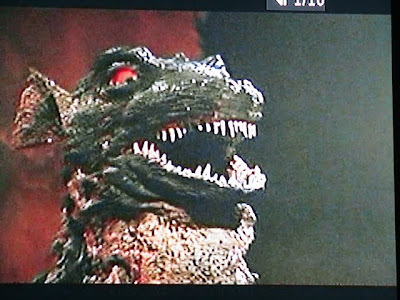

Godzilla’s Revenge (1969)
Cast & Crew
 Snarksters love to take a hot shit on Godzilla’s Revenge, but I doubt most of these people have just sat down and tried to treat this like any other movie: by watching it.
Snarksters love to take a hot shit on Godzilla’s Revenge, but I doubt most of these people have just sat down and tried to treat this like any other movie: by watching it.Unfortunately having Godzilla in Godzilla’s Revenge only helps confuse the issue.
This movie is generally reviled by people expecting a Godzilla movie, and in some ways you can’t blame them: a Gojira kaiju movie was promised, and instead they get a lyrical, but semi-realistic (bordering on kitchen-sink) tale about a lonely, bullied boy—the quintessential latch-key child, with overworked, often-absent parents—
who seeks help from the fantasies in his head—all of which have been inspired by Godzilla movies….
.jpg)
Angry viewers wanted Destroy All Monsters, and instead, they got the Little Fugitive—
with a touch of Fight Club. [Little Fugitive review below]
 That’s right: Godzilla’s Revenge is NOT a Godzilla movie, it’s a movie about a Godzilla fan—that’s why the majority of the Godzilla scenes are stock footage—
That’s right: Godzilla’s Revenge is NOT a Godzilla movie, it’s a movie about a Godzilla fan—that’s why the majority of the Godzilla scenes are stock footage—Clips from Godzilla vs. the Sea Monster, Son of Godzilla, King Kong Escapes and either Atragon or Destroy All Monsters are reused because these are the movies that Ichiro, our lonely little boy protagonist (played by Tomonori Yazaki), has seen.
Ichiro’s powers of imagination are so great, they are almost like astral projections teleporting him to Monster Island, where the kid meets and befriends Minya, Godzilla’s blobby progeny—in the English dubbing, Minya’s given a “hopey-dopey-aw-shucks” hick accent.
Hanging out with Minya and watching Godzilla kick ass, take names and smash up a giant spider, a giant lobster, some jet fighters, and more giant bugs, Ichiro has the time of his life, but—
Little Minya has his own bully issues: a giant electrified goblin who not surprisingly has the same name as Ichiro’s bully, Gabera.
Together, the little boy and the little monster learn to be brave and to stand up for themselves with courage—which helps Ichiro in the real world when he’s taken hostage by bank robbers….


While we’re never shown any movie marquees or a Godzilla movie on TV, not once in Godzilla’s Revenge do I feel that the audience is supposed to believe that this takes place in a world where Godzilla & crew actually exist. This isn’t part of any continuity, this is happening in the “real” world—reinforced by the factory landscape and junkyard wasteland Ichiro’s family lives in (shades of Paper Street in Fight Club—and Eraserhead).
.jpg)

When I first saw Godzilla’s Revenge, I was a kid and I HATED this flick: It wasn’t a Big G flick per se, and hell-to-the-no, I did not want to see a flick about me (a lonely latch-key kid with a hyperactive imagination), I wanted GIANT LIZARD MASSIVE DESTRUCTION.
I didn’t want lyricism and emotional realism—I wanted pre-adolescent power fantasies, where my nihilism is projected onto the Giant Monster destroying Tokyo or Osaka or Kyoto, venting my powerless frustration—my own bit of astral projection.
 Godzilla’s Revenge would be better remembered today if:
Godzilla’s Revenge would be better remembered today if:A) It had a different title, one that doesn’t raise audience expectations so much—
like perhaps “Ichirō no fukushū” (Ichiro’s Revenge), or “Monsutā ga dono yō ni shite taisho suru ijime o oshiete kuremasu” (Monsters Teach Us How to Deal With Bullies) or maybe even “Sei hōkō no kōjō to jiritsu o kumiawaseru koto de sōzō-ryoku” (Imagination Combined with Positive Direction Increases Self-reliance).
or:
B) if the flick had used some other monster, preferably an original one—which would’ve meant 100% new kaiju footage (which means the film would’ve needed a bigger budget—and therefore probably would never have been made…).
Personally, I think a remake of Godzilla’s Revenge would be perfect as a child-friendly coming-of-age story—but only if suggestions A) and B) are followed.
Godzilla’s Revenge is a meta-movie, commenting on itself as a genre as well as its influence on the world beyond what is kept in celluloid, very much like the pleasant and recommended Son of Rambo but it’s not as OBVIOUS as it needed to be for the average viewer to get it.

Toho Studios is notoriously protective of its cash-cows’ images, and may have prevented too much “reality breaking” from occurring in Godzilla’s Revenge—which is why we’re never shown any movie marquees or a Godzilla movie on TV. It’s like some Toho exec didn’t want the audiences to think that Godzilla was only an “imaginary” character.
 I will admit that Godzilla’s Revenge came at a strange time for Godzilla and Toho, as the company was trying to find new ways to keep the franchise viable—this film is the transition point where, borrowing a page from the Gamera playbook, Godzilla completely switches from “villain” to “Friend of the Earth and Especially Children.”
I will admit that Godzilla’s Revenge came at a strange time for Godzilla and Toho, as the company was trying to find new ways to keep the franchise viable—this film is the transition point where, borrowing a page from the Gamera playbook, Godzilla completely switches from “villain” to “Friend of the Earth and Especially Children.”Remember, the film after Godzilla’s Revenge was Godzilla vs. the Smog Monster (a psychedelic classic!), and then that film was followed by the movies where baseball capped moppets beg the Big Green Thing to save Nippon.
Before that, Godzilla’s films were always combinations: King Kong vs. Godzilla was a kaiju/salaryman comedy mash-up, and Godzilla vs. the Sea Monster was a combo of the Polynesian-surf genre then popular in Japan with big monsters, and even Godzilla vs. Monster Zero combined kaiju with the space invasion genre.
With Godzilla’s Revenge, Gojira became a kid’s show.
Meanwhile, as one of longtime Godzilla director Ishiro Honda’s last films, Godzilla’s Revenge gives him the chance to try something different.
But don’t let that stop you from enjoying this sweet, but hardly saccharine story.


And speaking of films about children that aren’t necessarily kid stories…
Little Fugitive (1953)
CAST & CREW
 Stick with this movie; it will grow on you. Little Fugitive is not slick or cool, but it is a genuinely sweet and charming film.
Stick with this movie; it will grow on you. Little Fugitive is not slick or cool, but it is a genuinely sweet and charming film.There are comic “bits,” but they always surprised me by going in unexpected directions: set-ups that, in a mainstream Hollywood flick would lead to “whacky hijinks,” are here treated realistically and develop in a more emotionally satisfying manner. (Sorry I’m being obtuse about details, but discovering Little Fugitive on your own is part of its joy.) The first 10 minutes drag, and the acting is unfortunately amateurish at the beginning, but once the plot gets rolling and little Joey finds himself at Coney Island, the movie really comes alive.
Absolutely beautiful cinematography captures life on the Boardwalk and at the amusement parks, and the kid playing Joey is obviously having a blast (when he’s not worried about having “killed” his brother).
Sometimes there’s the feeling that this is some kind of cinema verite-style After School Special, but Little Fugitive never gets moralistic or preachy. This is a film I could recommend as “for the whole family” without reservation—except that kids would probably be bored by the movie’s more leisurely, 1950s pace.
However, you can see how Little Fugitive influenced films like The 400 Blows, and for fans of old New York City, especially Coney Island “back in the day,” this movie is a must-see. (And if you rent this DVD, make sure to watch the trailer, too: it’s hilarious how it misrepresents Little Fugitive while at the same time being quite honest about the film. It’s really smart marketing.)





























.jpg)




















































